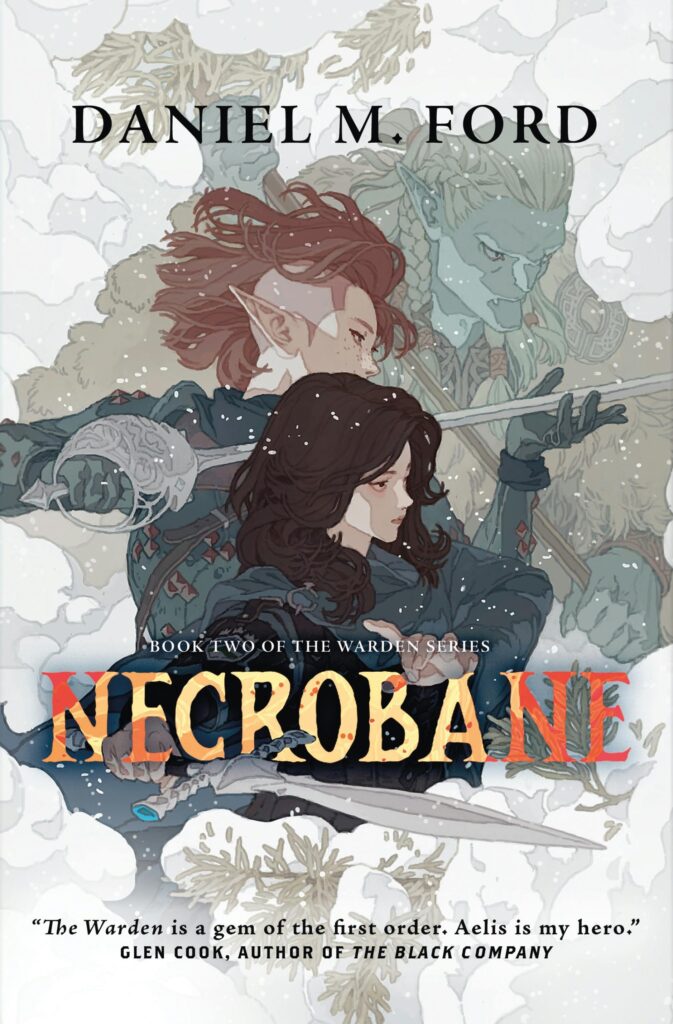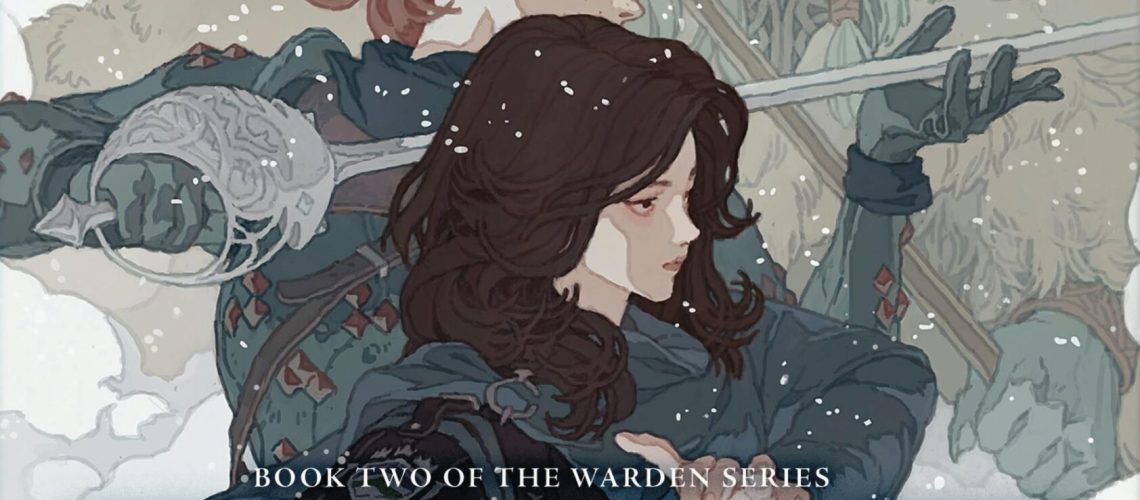Daniel M. Ford’s Necrobane continues the story of Aelis de Lenti, reluctant Warden and hero on the frontier, trying to clean up the mess she accidentally created.
We last left Aelis De Lenti, Warden of the border town of Lone Pine, in quite a predicament. At the end of The Warden, Aelis, in following the path of good intentions to investigate a problem set by her mentor, managed to unleash a horde of undead onto the northlands. The Warden ended on that cliffhanger. Necrobane, book two of the series, picks up from that cliffhanger in that exact moment, and continues the story.

As such, this is not a book that can be effectively read on its own. But the basic premise of this fantasy world is that magic users are crown employees and many are engaged in a sort of marshall or sheriff capacity, a role called Warden. The ambitious and urbane Aelis, daughter of a nobleman, wants a path of her own and a chance to shine. So she studied magic to become a Warden, hoping for a city posting. Instead, she was given a posting at the literal edge of civilization in the tiny village of Lone Pine. Beyond Lone Pine was the wilderness, full of orcs, and ruins of a fallen empire, and wilder, stranger things. Aelis is a stranger to the small town, and found it rough there, not only because it was far from the comforts of what Aelis calls civilization, and not only because the people of Lone Pine are an isolated and a bit insular in regards to strangers, but because of her skill set.
For you see, every Warden has a speciality or two in magic. And Aelis’ greatest speciality is an unusual and misunderstood one—Necromancy. Aelis is not the kind of Necromancer who raises skeletons and zombies (although she does know how, it’s in the training course). No, Aelis has a good amount of skill in stopping and disabling and ending the power of skeletons and the like (as well as using Necrotic energy for other purposes). Aelis is in fact, the titular Necrobane.
But while handling a single crypt of undead might be well within her powers, a horde of the undead from a swath of crypts across the region is a bit beyond a recently graduated Warden or perhaps even a moderately skilled and talented one. Aelis is going to need a lot of help, and so turns to a local tracker, and to the adventuring company, including her would-be girlfriend, for aid in going after the source of the problem in the heart of the wilderness. And therein lies the plot.
The worldbuilding and the world of the Warden are deepened and focused on several areas in this second volume in the series. The first volume did a lot of the heavy lifting of the worldbuilding in terms of the geopolitical setup, the basics of magic, the academy and the early life of Aelis, as well as her getting a foundation of a life in the village of Lone Pine. This novel takes that all as read and develops further. The area of Lone Pine, including Malgrim Keep and other areas, is fleshed out much more. In the first book, it was very much the edge of terra incognita. In this book, it is much more of a jumping off point, but it is also a place of transition, a boundary area, a polder between the ordinary world of the three kingdoms that Aelis came from, and the wild wilderness that lies beyond. But that wilderness is not quite so trackless; it has places, locations, definition to it in a way it did not in the first book.
To use a D&D analogy, the village of Lone Pine is the Keep on the Borderlands. In the first book, Aelis arrives there, starts to get to know the inhabitants, but does not really understand the wilderness beyond the Keep even though she visits it. In this second book, that map of the borderlands is more filled in, has location and definition. And Lone Pine, alien and unfamiliar in the first book, feels much more like home, like the place a group of adventurers knows and even comes to love.
And you can even see this in the maps. The map in the first book is one of the whole three Kingdoms, with Lone Pine all the way up at the edge of the map. The map in Necrobane focuses around and gives detail to the area of Lone Pine, showing a more intimate understanding of the area around it.
The characterization of Aelis, in particular, really shines and stands out in the work. I’ve given some of the game away, already. In the first book, she is, to use a metaphor from M*A*S*H, very much like Major Winchester. She doesn’t even know what she is even doing *here*, there had to have been some sort of mistake. At least it wasn’t a case of beating someone at cribbage(1). She’d rather be back in a big city, getting drunk, and finding lovers of either gender (which is not commented on, this world is definitely queernorm). But now that she is stuck with this position and location, she DOES buckle down to do her job. Even if the wine around here isn’t good. And then there was that goat. And of course, the threats and problems of living at the edge of civilization.
By the end of the first novel, it seems that Aelis has taken pride and is fully integrated into the fabric of Lone Pine. She’s now part of the community. And that is what she seems to believe, and that is what she professes to the community and to anyone who will listen. The subtlety and the nuance here is that Aelis’ conversion is not as simple and direct as one might think, and that Aelis must confront this. The premise of the entire character arc and Aelis’ plot and character arcs get called into question and examined. It’s a very interesting deconstruction of the character on a number of levels. Some of the less than smart choices Aelis made in the first book, and in this book, really do come back on her. This is a book that is all about the consequences of personal actions, on scales ranging from Aelis’ health, to the fate of a friend, to the main plot, the wave of undead threatening the borderlands that she set in motion.
This all makes Aelis an even more interesting and flawed and complicated character by the end of the first book. She wasn’t a Mary Sue in the first book but we really get a full rounded picture of her by this second book as a complicated and interestingly flawed character. Don’t get me wrong, I’d want her on my team in a conflict. She’s dedicated, stubborn, intelligent, clever, and skilled. But she does think without acting, can be awfully selfish and narrow minded, and sometimes needs to actually stop and take care of herself. And it takes other people, often, to call her out on her bullshirt, to use a contemporary term. The credit lies in her actually trying to DO better. That’s what heroes, or Wardens, need to do.
This read of the book was in fact, a re-read, via the audio book. The narrator is Lindsey Dorcus, who has also notably done the narration for the Malka Older Mossa and Pleiti books. Her narration of the story is engaging and excellent. There is one interesting bit that I didn’t even think of when I first read the book, but came clear in her narration, is that Aelis’ name, as pronounced by the narrator, has a bit of a soft h to end of the name. Before listening to the audiobook, I had always had a harder s sound in my mind to the name.
The novel seemingly completes the storyline of the first two novels as far as the main threat (although a number of serious consequences and results remain from it). However, this novel, though, does the same trick as the first, and ends with a cliffhanger. It’s a cliffhanger of a rather different sort than the first and is much more personal to Aelis’ own past and seems that it will take Aelis away from Lone Pine entirely. I do look forward to The Advocate, and the continuation (perhaps the conclusion) of Aelis’ story.
- There is no cribbage in this ‘verse, although there is “Orcish Chess”, which, as described in the book, is much less like chess and more like the asymmetric board game Gwyddbwyll.







